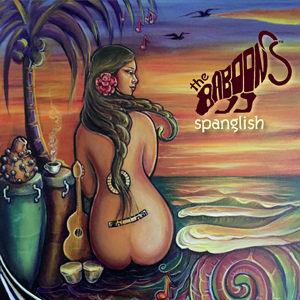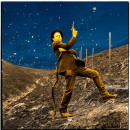Musicians are always looking for ways innovative sound, but very few achieve what The Baboons have. Their mix of Afro-Cuban, jazz, rock, blues, pop and doo-wop has always given them something that goes beyond definition, so much so that since their appearance on the Miami scene twenty-five years ago, they’ve often been labeled “world.”
Spanglish, the band’s newest release, takes this revolutionary fusion sound even further by pushing the barriers of genre, language, and melodic and harmonic experimentation into new realms.
The first three tracks alone couldn’t be more disparate. The album opens with the instrumental “Balkan Thang,” with a heavily ornamented, melody performed by the band’s saxophonist that evokes Eastern European folk, jazz, and klezmer all rolled into one. However, an electric guitar riff reminiscent of Carlos Santana’s early work follows, shows us that the Eastern European sound is merely an influence and not a definer.
The second track, “Spanglish,” features lead singer Majica’s sultry, pop-inspired vocals, mixed in with an Afro-Cuban riff on the piano, a Latin jazz-influenced harmony on a small brass section, and a jazzy, blues electric guitar again reminds listeners of Santana’s early work. The lyrics are equally dynamic, telling the story of a young woman who leaves the northern United States to live in Miami, where she learns how to speak “Spanglish.” As a result, Spanish words are placed throughout this song, demonstrating the protagonist’s progress from zero-knowledge to fluency.
The third track, “Que Tiene Que Ver” (What You Have Is What You See) truly defies the idea of genre or tradition. It is the first track on the album completely in Spanish, yet doesn’t sound like the average Spanish pop, rock, or even like a salsa track. The lyrics examine philosophical ideas of what enriches (and doesn’t) life, while the melody is more vocally and instrumentally driven than rhythmically.
The salsa influences are much greater on Spanglish’s fifth track,“El Tiki Tiki,” which is a classic Salsa song, more in the vein of Celia Cruz or Marc Anthony. While the lyrics—about a young woman named Ana, who encounters a tiki—may not fit in with a traditional salsa song, the rhythm does, with Latin jazz piano and extensive horn section.
Their mix of Afro-Cuban, jazz, rock, blues, pop and doo-wop has always given them something that goes beyond definition...
In addition to an eclectic sound of the album, the lyrics also reflect a diversity of language and story. The song “Dashiki Blue” tells the story of a young Nigerian woman living in Florida, who is reminded of her homeland every time she sees the color of dashiki blue. “Ceboilla,” is about an old, Cuban horn player who has a “sharp” spirit and attitude, hence his stage name, Ceboilla (onion in Spanish).
Some songs are completely sung in English, like “Sugarcane” and “This Is Me,” while “Spanglish” and “Pequeña Habanera” are performed in Spanglish. “Alborata” and “El Tiki Tiki,” on the other hand, are completely sung in Spanish.
Not bands are brave enough to release such a multicultural and bilingual album. However, The Baboons do so magnificently by combining story-driven lyrics with melodic and rhythmic experimentation to create the unique music featured here on Spanglish.













